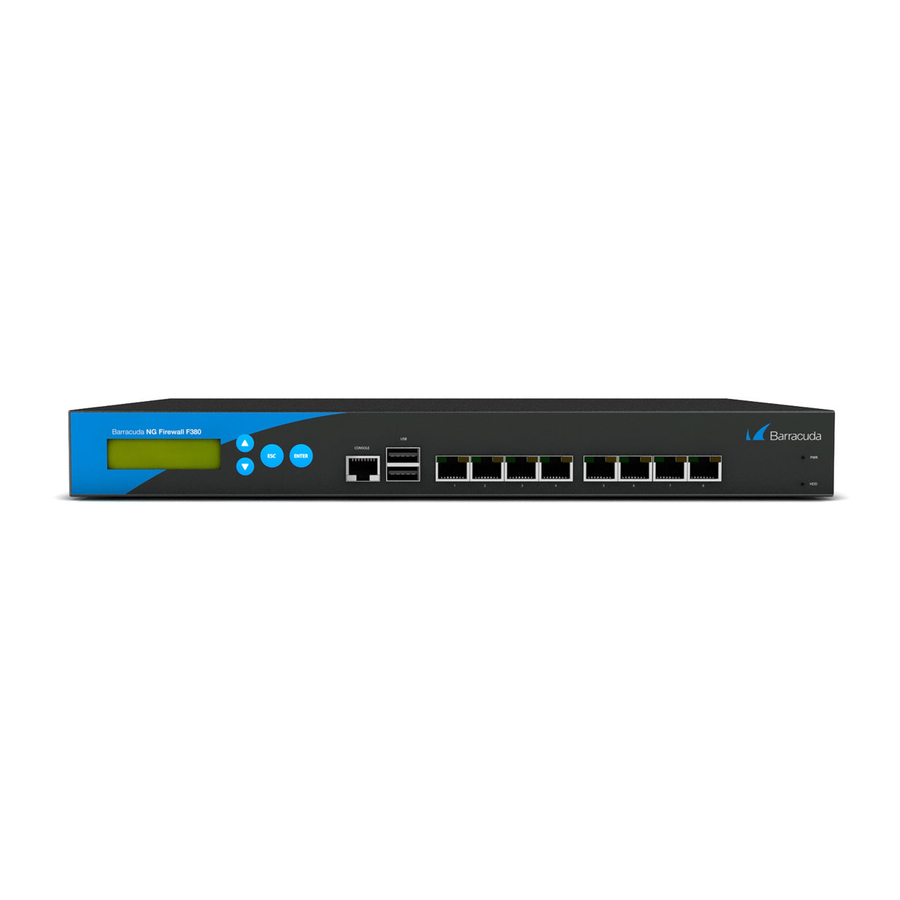Table of Contents
Advertisement
Quick Links
The Barracuda SSL VPN provides remote users secure, clientless access to their internal
network. The Barracuda SSL VPN may be installed directly inside the LAN or in a more
complex DMZ configuration.
Getting Started
Follow the instructions in this guide to configure the Barracuda SSL VPN to
accept incoming connections from the Internet. To begin setting up your
Barracuda SSL VPN, you will need the following:
Barracuda SSL VPN
AC Power Cord
Ethernet Cables
VGA Monitor (recommended)
PS2 Keyboard (recommended)
Physical Installation
To install the Barracuda SSL VPN:
1. Fasten the Barracuda SSL VPN to a 19-inch rack or place it in a stable
location.
2. Connect an Ethernet cable from your network switch to the Ethernet port on
the back of the Barracuda SSL VPN.
3. Connect a VGA Monitor, PS2 Keyboard, and AC power cord to the unit.
4. Press the power button on the front panel to turn the unit on.
Configure IP Address and Network Settings
If you have a monitor connected, the Barracuda SSL VPN will display the Boot
Menu initially, and the Administrative Console login prompt once fully booted. To
begin the configuration:
1. Login to the Administrative Console using the admin login:
admin
Login:
admin
Password:
2. Configure the IP Address, Subnet Mask, Default Gateway, Primary DNS
Server and Secondary DNS Server as appropriate for your network.
If you do not have a monitor and keyboard and want to set the IP address using
the RESET button on the front panel, press and hold the RESET per the
following table:
IP address
192.168.200.200
192.168.1.200
10.1.1.200
Press and hold RESET for...
5 seconds
8 seconds
12 seconds
Barracuda SSL VPN - Quick Start Guide
Open Firewall Ports
If your Barracuda SSL VPN is located behind a corporate firewall, open the
following ports on your external firewall to ensure proper operation:
Port
Direction
TCP
UDP
22
Out
Yes
No
25
Out
Yes
No
53
Out
Yes
Yes
80
Out
Yes
No
123
Out
No
Yes
443
In
Yes
No
8000
Out
Yes
No
8000
In*
Yes
No
8443
In*
Yes
No
* Only if appliance management is performed from outside the corporate network
he following ports must be opened if the listed type of access is desired:
T
1723
In
Yes
No
500
In
No
Yes
4500
In
No
Yes
** Note: PPTP access also requires GRE (IP protocol 47)
If you also have an internal firewall (due to placing the Barracuda SSL VPN in a
DMZ, for example), then the following must be allowed on your internal firewall:
389
Out
Yes
No
636
Out
Yes
No
Barracuda SSL VPN Configuration
Use a computer with a Web browser that is connected to the same network as
the Barracuda SSL VPN and follow these steps:
1. In your web browser's address bar, enter http:// followed by the IP address of
the Barracuda SSL VPN, followed by the default Appliance Administrator
web interface HTTP port (:8000). For example, if you configured the
Barracuda SSL VPN with an IP address of 192.168.200.200, you would type:
http://192.168.200.200:8000
2. Log in to the Appliance Administrator web interface as the administrator:
Username: admin
3. Go to the BASIC > IP Configuration page and perform the following:
Verify the IP Address, Subnet Mask, and Default Gateway.
Verify the Primary and Secondary DNS Server.
Enter the Default Hostname and Default Domain.
If you are using a proxy server on your network, you should also verify the
Proxy Server Configuration settings.
4. Complete the rest of the fields on this page and save your changes.
Usage
Remote diagnostics and service (recommended)
Email alerts + One-time passwords
Domain Name Service (DNS)
Firmware and definition updates
Network Time Protocol (NTP)
HTTPS/SSL port for SSL VPN access
Firmware and definition updates (backup)
External appliance administrator port (HTTP)*
External appliance administrator port (HTTPS)*
PPTP access**
L2TP/IPsec access
L2TP/IPsec access
LDAP/Active Directory read access
LDAP/Active Directory read/write access
Password: admin
Barracuda SSL VPN
Advertisement
Table of Contents

Summary of Contents for Barracuda Networks Network Router
- Page 1 The Barracuda SSL VPN provides remote users secure, clientless access to their internal network. The Barracuda SSL VPN may be installed directly inside the LAN or in a more complex DMZ configuration. Getting Started Follow the instructions in this guide to configure the Barracuda SSL VPN to accept incoming connections from the Internet.
- Page 2 Barracuda Networks, Inc. 3175 S. Winchester Blvd, Campbell, CA 95008 USA phone: 408.342.5400 fax: 408.342.1061 www.barracuda.com Copyright 2004-2012 Barracuda Networks, Inc. All rights reserved. Use of this product and this manual is subject to license. Information in this document is subject to change without notice.


Need help?
Do you have a question about the Network Router and is the answer not in the manual?
Questions and answers